Cress includes some edible plant species with the most varied of requirements. We introduce you to the best types and varieties of cress.

The various types of cress all belong to the order of cruciferous plants (Brassicales) and have a spicy-hot taste. These cress varieties are edible in all parts of the plant and have an antibacterial effect thanks to the pungent mustard oils they contain. Depending on the place of origin, cress can be hardy and perennial or annual, which is important to consider when growing. We present the most important types of cress and their demands on the location.
contents
-
Cress species: Nasturtium
- Canary Nasturtium (Tropaeolum peregrinum)
- Tuberous Nasturtium (Tropaeolum tuberosum)
- watercress
- garden cress
- maca
- Pepperwort
- arrowcress
- winter cress
- American land cress
- Japanese flower cress
Cress species: Nasturtium
the Nasturtium (tropaeolum) is a popular summer flower. All parts of the plant are edible and complement salads and other dishes with the hot and spicy taste and the colorful flowers. Our annual plants originally come from Central and South America and are not frost hardy. Nasturtiums are therefore grown from seed every year. Plants produce fleshy stems that are woody at the base and round to lobed leaves. The buds of most strains glow with the colors of the sunset - bright yellows, flaming reds and oranges, and velvety burgundy. Some varieties even surprise with different colored, striped or spotted flowers. There is a large variety of nasturtiums - we present the most beautiful varieties below.
Especially suitable for the Cultivation of nasturtium in the pot are varieties of the small nasturtium (Tropaeolum minus), which, in contrast to its larger relatives, is only about 30 cm high and grows rather bushy. The Great Nasturtium (Tropaeolum majus), however, forms 1 to 3 m long tendrils.
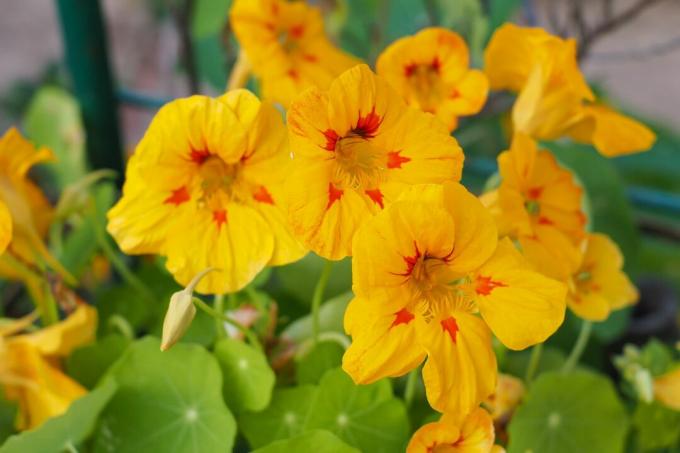
- 'Banana Split': Attractive banana-yellow flowers with an orange tinge at the base and a slightly overhanging one growth make this variety of the large nasturtium the perfect potted plant for patios and balconies.
- 'Black Velvet': This variety of the small nasturtium impresses with its velvety, black-red flowers. The black nasturtium 'Black Velvet' reaches a height of about 30 cm.
- 'milk maid': Creamy white flowers adorn this variety of large nasturtium and give it a delicate appearance.
- 'Phoenix': The Phoenix nasturtium is a real feast for the eyes: its flowers captivate with yellow, red and apricot-colored tones and an unusual shape with fringed petals.
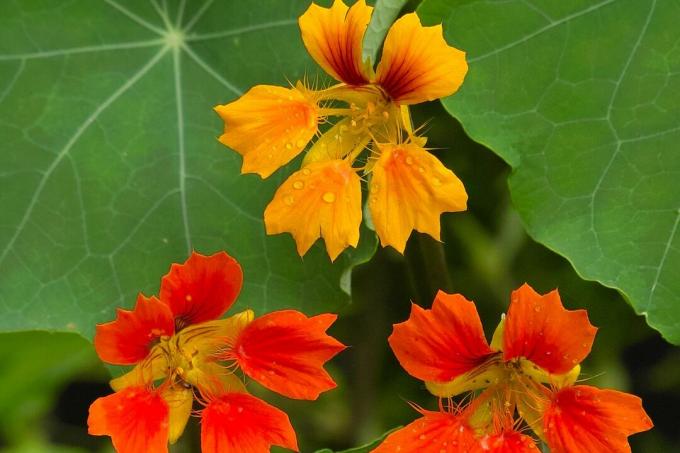
- 'Variegated Queen': This unusual variety of large nasturtium has variegated, white-green speckled foliage. The nasturtium 'Variegated Queen' forms different colored flowers from bright sunny yellow to strong red.
- 'Vesuvius': Historic cultivar with a bushy, low habit and salmon pink flowers. The small nasturtium 'Vesuvius' reaches a height of 15 - 30 cm.
- 'Whirlybird Rose': Pink, semi-double flowers and a bushy growth of up to 30 cm make this low nasturtium variety so appealing.
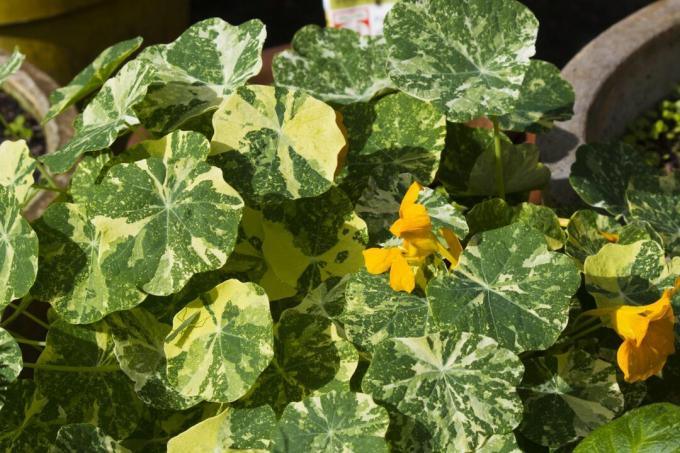
For planting nasturtiums in pots, but also for improving bedding soil, we recommend using a high-quality, pre-fertilized potting soil, such as ours Plantura organic potting soil. The completely peat-free substrate can be used for a wide variety of flowering plants and, thanks to the high compost content, stores sufficient moisture for the plant roots.
Canary Nasturtium (Tropaeolum peregrinum)
The fringed flowers in bright yellow and the palmately lobed leaves make this species a feast for the eyes. Compared to the large nasturtium, it is more climbing-friendly and can grow up to 4 m high. It owes its name to large wild populations on the Canary Islands.
Tuberous Nasturtium (Tropaeolum tuberosum)
A real rarity is the bulbous nasturtium, also called mashua. This is grown in South America as a frugal tuber vegetable and even thrives in our latitudes in summer. Gardeners who are only interested in the ornamental value of the tuberous nasturtium can overwinter the brightly colored tubers frost-free, like dahlias, and plant them again from April. This climbing nasturtium develops edible flowers and leaves.

watercress
the watercress (nasturtium) is also known as watercress. It is an aquatic plant with tasty, spicy-hot leaves. It prefers to grow on shallow, flowing waterfront zones up to 20 cm high or in shady wet beds. The plants, which are 30 to 50 cm high, always need sufficient water and temperatures that are not too hot to thrive. The watercress, also known as watercress, rewards you with vitamin-rich greens in the cold season between autumn and spring. Watercress is hardy to below -20°C and produces delicate, white flowers between May and June the following year. There are different types of watercress, all of which are native and have the typical, spicy-hot taste:
- Echte watercress (Nasturtium officinale): Large-leaved watercress with green foliage and a growth height of up to 60 cm.
- Red watercress (Nasturtium officinale f. rubrum): Form of the watercress with dark red leaves and mostly green leaf veins.
- Small-leaved watercress (Nasturtium microphyllum): Rather compact habit with small leaves and a height between 20 and 100 cm. In autumn, when the temperatures are cool, the leaves turn brownish.
- Brown watercress (nasturtium x sterile): Barren, naturally occurring hybrid of common watercress and small-leaved watercress with bronze colored foliage and particularly good vigour. The plants are only about 30 cm high.
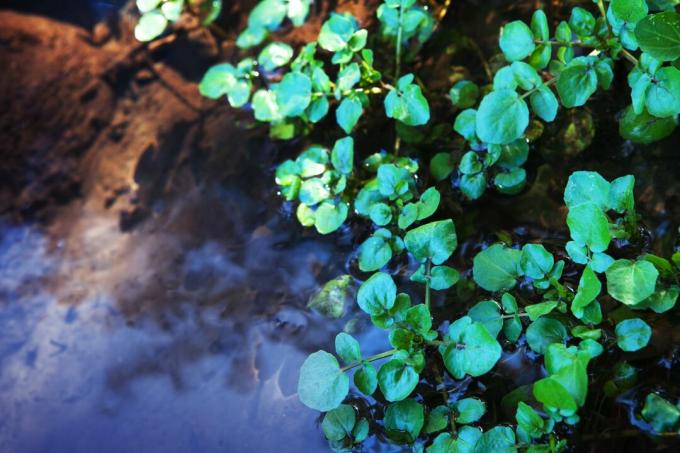
garden cress
garden cress (Lepidium sativum) is a classic among the sprouts and microgreens. The red-brown seeds, which germinate extremely quickly, can be grown all year round on a bright window sill in just a few days to produce hot, spicy little plants that are ready to harvest. The large number of useful ingredients is usually left out when choosing a variety, because the cress should germinate quickly and evenly. In addition, intensive breeding processing of the garden cress is not very lucrative for the breeding companies. Therefore, the number of different garden cress varieties on the market is very limited. However, cress can also be grown in the garden and, as a stately plant, develop the spicy leaves that we appreciate in the kitchen for much longer. Garden cress thrives on all nutrient-rich garden soil, as long as there is no waterlogging. Basically, you can differentiate cress varieties according to the leaf shape and size:
- Broad Leaved Cress: Also known as Great Garden Cress; develops strikingly large and broad, oval leaves.
- Curled Garden Cress (Curled): Garden cress variety with slit to slightly wavy leaves.
- Plain Leaved Cress: garden cress with simple, smooth and wavy leaves; the most common cress variant.
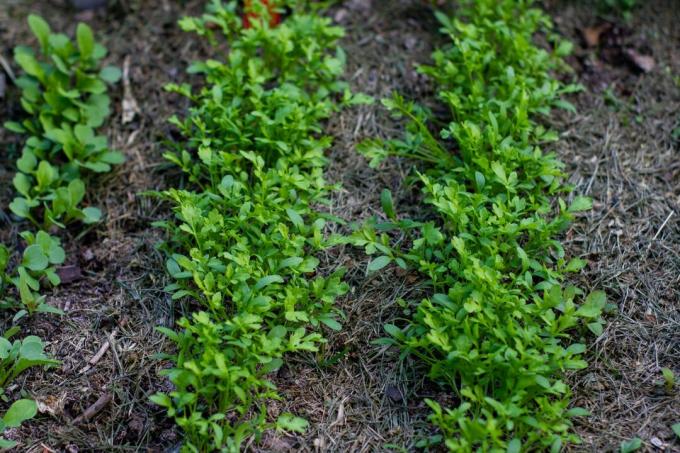
maca
The Maca (Lepidium peruvianum) is a species of cress in which the focus is on the roots, which have grown into tubers. Maca, which comes from Peru, only develops beets about the size of a walnut with white, yellow, red or black skin. In addition to these, the finely feathered leaves on the fleshy petioles can also be eaten. The entire maca plant tastes like cress and thrives in our latitudes. The location should ideally be sunny to semi-shady, humus rich, nutritious and well watered - but the Maca grows even on poor soil. The cress species is sown in May after the ice saints. By autumn, the small turnips with a sweet and spicy taste will develop on the plants, which can be up to 30 cm high. They can be eaten raw, baked or fried, or dried. The Maca plant is basically hardy and perennial. To gain seeds yourself, you can leave some plants instead of harvesting them. Maca is known as an invigorating, strengthening and slightly bitter-tasting powder.

Pepperwort
The Pepperwort (Lepidium latifolium) is also known as perennial cress or broad-leaved cress. It is closely related to garden cress and arrowhead and forms oblong to oval leaves up to 40 cm long. They have the typical hot and spicy cress taste and can help to clear the upper respiratory tract when you have a cold. The delicate white, small flowers, which are clustered in clusters, can also be used in the kitchen. The plants themselves grow up to 100 cm high, are robust, perennial and can spread widely in suitable places. However, the pepperwort can be planted in larger pots. The optimal location is sunny to semi-shady on all permeable soils.

arrowcress
The arrowcress (Lepidium draba), also known as Turkish cress or heart cress, is closely related to garden cress. It originally comes from the Mediterranean region and is now widespread in Germany. The 30 to 60 cm high, perennial plants form a dense network of rhizomes from which they grow numerous upright root shoots. The arrowcress can therefore thrive clump-like to broadly spreading. The arrowcress prefers sunny, warm, permeable and nutrient-rich locations and is relatively hardy. Sowing takes place from March to April. The spicy, heart-shaped leaves can be harvested all year round. Perennial plants bloom white between May and July and serve as food for numerous insects. Arrowcress seeds used to be ground and used as a substitute for pepper.

tip: The local field cress (Lepidium campestre) is edible, although it is not popular as an arable weed. The approximately 30 cm high plant throws its numerous seeds far away when the pods are ripe and can therefore spread quickly.
winter cress
the winter cress (Barbarea vulgaris), also known as Barbarakraut or Barbara cress, is an undemanding winter leafy vegetable. The extremely frost-tolerant and completely hardy plants grow up to 30 cm high. In the cold season they provide vitamin-rich and slightly spicy, small, cabbage-like leaves. Winter cress is sown for winter culture from August to the end of October outdoors or in an unheated greenhouse. From April to June of the following year, the yellow, fourfold flowers of winter cress appear on long, dense, racemose inflorescences up to 90 cm high. They are also edible and have a spicy-hot taste. The optimal location for winter cress is on fresh, nutrient-rich soil in full sun to partial shade.
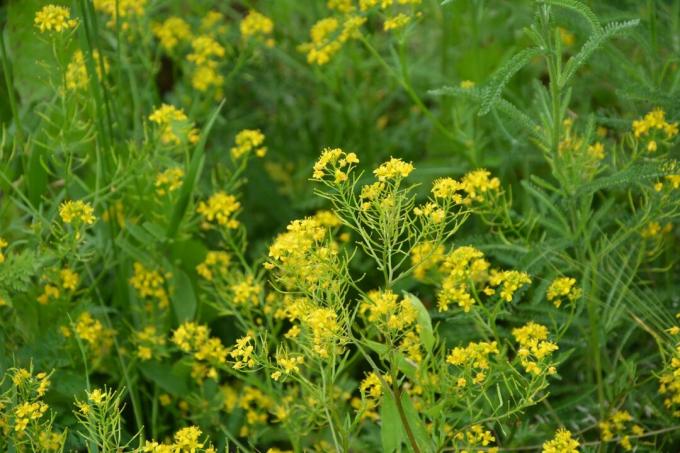
American land cress
The American Landcress (Barbarea verna) resembles watercress in taste, but does not thrive in water but on land. Together with the inflorescences, it can reach a height of about 30 cm. Like its relative, the winter cress, the land cress prefers cool temperatures, making it ideal for fall and spring cultivation. In the first year, the plants form leaf rosettes with unevenly pinnate leaves, which have a spicy-hot and slightly bitter, invigorating taste. Yellow flowers appear the following year, from which seeds are harvested.

Japanese flower cress
The Japanese flower cress (orychophragmus) also belongs to the cruciferous family and comes from Asia. The Japanese cress is also known as violet cress because, unlike many cabbage plants, its flowers are not white or yellow, but violet in color. The leaves are rounded to ovate and slightly lobed at the leaf margin. The biennial plants reach a height of 15 to 60 cm and prefer sunny to partially shaded, fresh soil. The graceful flowering cress sows itself in suitable locations. The plants grow clumpy and bushy. Its leaves and flowers are edible and have the typical spicy-hot cress taste.
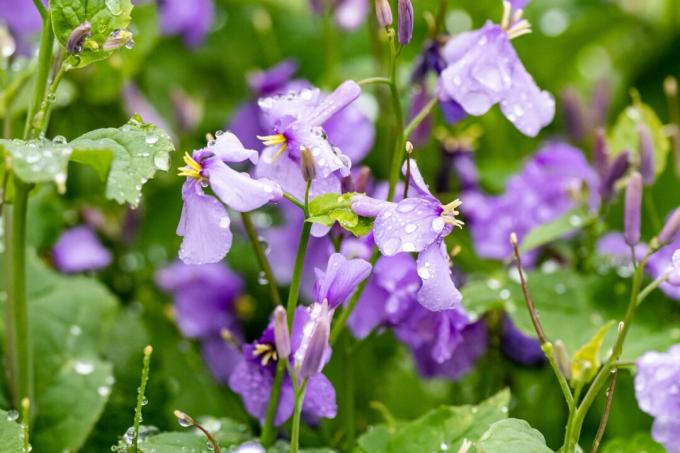
tip: The sweet herb, also known as honeycress (Stevia rebaudiana) is not a type of cress with a spicy taste, but a daisy family (Asteraceae) with an extremely sweet-tasting herb from which sweetener is obtained. The para cress (Acmella oleracea) or jambu with its slightly cress-like taste is also a daisy family. It is notorious for the tingling and sizzling on the tongue that is triggered when consuming the South American spice plant.
It is a relative of the garden cress spoonwort (Cochlearia officinalis). We provide tips on growing and caring for the healthy and undemanding herb.



